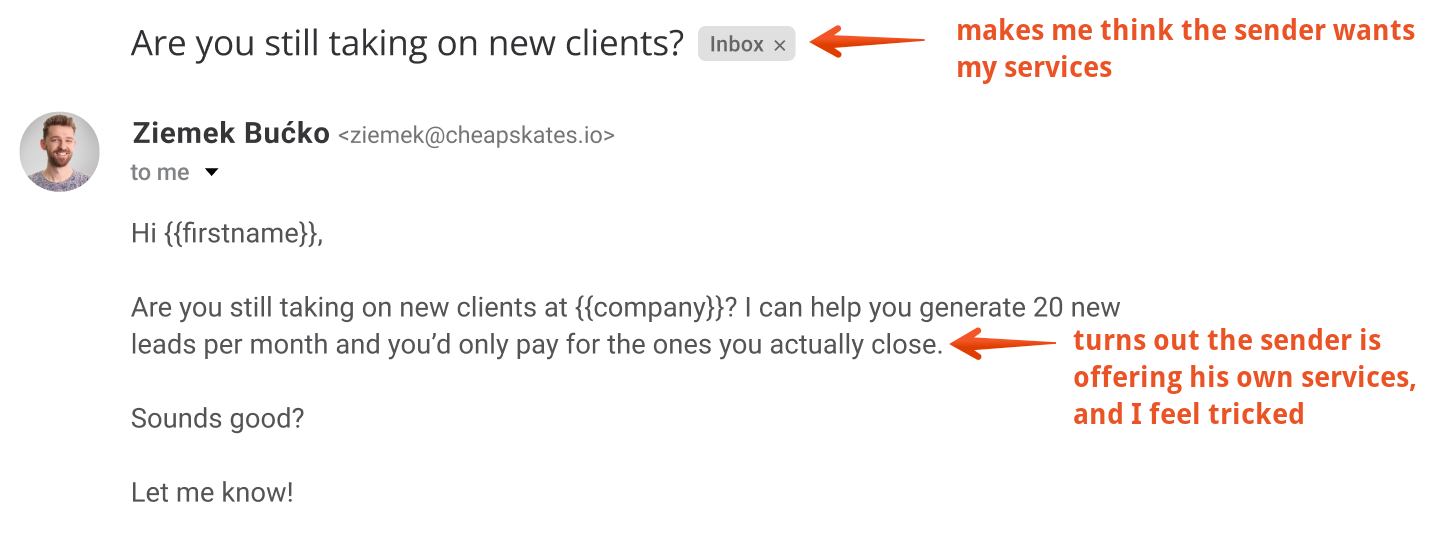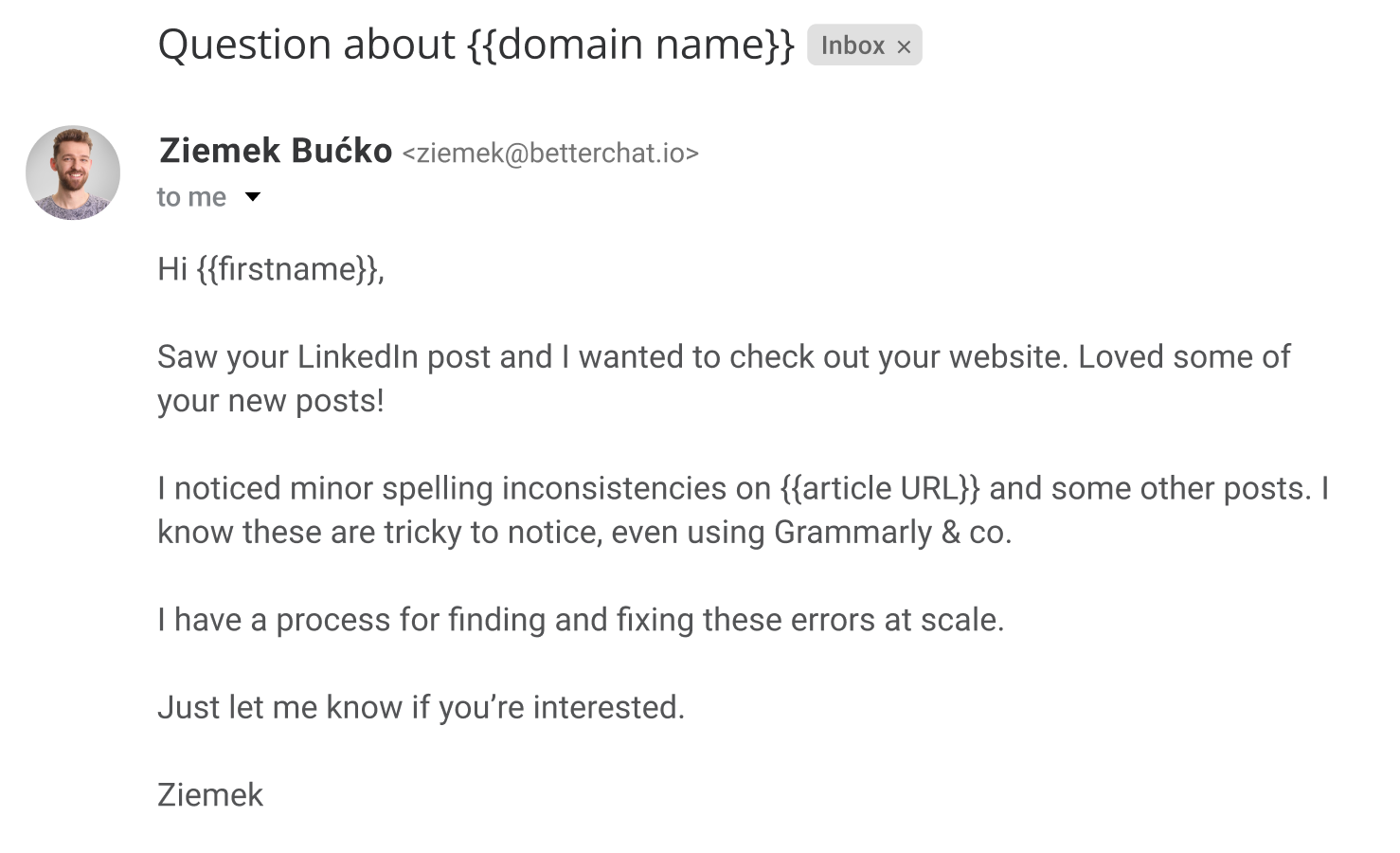The subject line is your first point of contact with your prospect.
From the start, you’re at a disadvantage – you’re just another item in their inbox. They hold the power.
But with a good understanding of your recipient and what you’re offering them, you’ll write a subject line that makes them not only open your email, but also develop the right expectations for what happens next.
In this article, I’ll cover:
- Goals to keep in mind when writing cold email subject lines,
- Tactics you can use to make your subject lines enticing, and
- Examples you can use as inspiration for your own subject lines.
What a subject line should achieve
Any good subject line should aim to achieve two goals:
Make the recipient switch to System 2
In “Thinking, Fast and Slow,” the great psychologist Daniel Kahneman claims people think in two modes:
- System 1 (fast thinking): this mode of thought is highly automated, driven by instinct, and helps us save time and energy. Example: solve 2+2.
- System 2 (slow thinking): this mode of thought is analytical and careful. While System 2 is better for making decisions, people avoid it because it takes more effort. Example: solve 14*49.
When your recipient is browsing their inbox, they typically use System 1 – quickly discarding all emails that don’t require their attention. Guided by habit and intuition, they look for important messages with a focus on emails from colleagues and clients.And when the recipient finds a relevant message, they switch to System 2 to read and analyze it more carefully.
As you’re neither a colleague nor a client, your cold email needs a subject line that will make the recipient switch to slow thinking.
Takeaways:
- Don’t use a subject line that could trigger a habitual response – don’t make it look like a cold email, a newsletter, or any other automated email.

- Use a subject line that either looks like an email from a colleague or breaks the pattern altogether.

Set expectations for the content of your cold email
Build a natural transition between the subject line and your email body. Remember that if you manage to get your email opened but don’t deliver anything that feels gratifying for the recipient, you won’t likely get a positive response.
That’s because the cognitive dissonance people experience from an expectation gap between your subject line and your email is bound to evoke negative reactions.
While you can use various attention-grabbing techniques, you should never be deceitful.

Subject line copywriting tactics
When looking for advice on writing effective subject lines, you’ll find hundreds, or maybe thousands of examples.
But example subject lines are only good if you also get the full context in which they were used – the ICP, timing, the contents of the email, and so on.
That’s why sharing tactics is better than sharing examples. If you know the types of tactics you can apply to your subject line, you’ll be able to choose something that works in the context of your outreach campaign.
Below, I’ll share some common tactics – pick the ones you think will work for your campaign. Remember that you can apply multiple tactics to a single subject line.
Curiosity gap
Curiosity is a powerful motivator. One way to tap into your recipient’s curiosity is the curiosity gap: the gap between what they know, and what they want to learn.
The key to creating a curiosity gap is to make the recipient aware that there’s something they should know, but don’t.
The better you know your audience, the easier it should be to leverage this tactic – you should try to leverage things that are the most interesting for your recipients.
Examples:
- “{{competitor}} is using this”
- “Your new article has two issues”
- “This is big for {{company}}”
- “Trouble coming in Q4”
Controversy/provocation
Being controversial in your subject line is a risky play.
On the one hand, controversy that’s relevant to the recipient is guaranteed to grab their interest.
But on the other hand, there’s nothing worse than an expectation gap between a provocative subject line and a weak email.
Using controversy is about tapping into your recipient’s existing beliefs, things they consider acceptable or mainstream, and presenting an opposing point of view.
Examples:
- “SEO won’t work for {{company}}”
- “Stop tracking your email opens”
Questioning
Some people may find questions stimulating, some may not. But there are some types of questions which can be especially enticing, and which you can use in your subject lines.
Interest and Expertise: People often enjoy answering questions about topics they are passionate about or have expertise in. This gives them an opportunity to share their knowledge and experiences.
Examples:
- “Your sales stack, {{firstname}}?”
- “Where do you source such rockstars?”
Relevance: Questions that are relevant to the recipient’s interests are more likely to be received positively.
Examples:
- “Your plan for Q3?”
- “What’s missing at {{company}}?”
- Curiosity: Questions that stimulate curiosity or lead to learning something new can be engaging and enjoyable for many people.Examples:
- “Have you thought about WARM?”
- “#1 success factor?”
- Validation: Getting questions on areas where individuals feel they can contribute significantly can be validating and boost self-esteem.Examples:
- “How did you build this {{firstname}}”
- “Is outbound working for you?”
Personalization
Personalization has become very easy to implement, and at this point, it’s table stakes.
It doesn’t mean you should always use the recipient’s name or company in the subject line, but when done right, it can work wonders.
Personalizing the subject line can reinforce the feeling that your email is relevant, and positively contribute to grabbing the recipient’s attention.
Examples:
- “This works great for {{company}}”
- “Congratulations {{firstname}}”
Non sequitur/incomplete thought
With this tactic, you’re trying to make your subject line look like it doesn’t belong in an email inbox.
A non sequitur is a statement that does not logically follow from the previous argument or conversation. In this context, your email wouldn’t naturally follow from your subject line, or at least not at first sight.
Examples:
- “And that’s when I knew it worked”
- “Blue elephants”
- “test”
Another way to achieve a similar effect is to use an incomplete thought.
- “Next quarter or”
- “Your recent post made me think”
Cold email subject line best practices
How long should a subject line be?
In my opinion, five words should be enough for most types of subject lines, and you should be worried if you need seven words or more.
However, I’m hesitant to suggest a fixed word count because it depends on the tactics you want to use in your subject line.
If you’re looking for a rule of thumb, here it is: Captivate – don’t explain.
As long as you stick to the goal of grabbing your recipient’s attention and avoid sharing too much about your offer, you won’t have to worry about the length of your subject line.
Is it okay to use emojis in the subject line?
Yes, you can use emojis in your subject line. But I wouldn’t necessarily recommend it.
Emojis are Unicode characters so it doesn’t inject HTML to your email (which you might want to avoid to maximize your deliverability.)
However, using emojis has some potential drawbacks:
- Some of your recipients may think it’s unprofessional.
- It makes your email look more like marketing, because people you know aren’t likely to use an emoji in the subject line when sending you a regular email.
Should I always personalize my cold email subject line?
No, personalization is fully optional. It’s just one of many tactics you can apply to your subject line.
Whether or not you should use it depends on your strategy for the sequence. If your first email contains some information that’s specific to the recipient or their company, you might be more successful with a personalized subject line.

Should I use humor in my subject line?
I don’t recommend it. There are two reasons why:
- Humor is subjective,
- Some recipients may not appreciate humor because they see it as unprofessional.
Next steps
With a diverse set of ideas for your subject line, you can get to writing the actual email. Keep in mind that the subject line and the email copy are two parts of a whole, and they need to naturally form a unified message.

